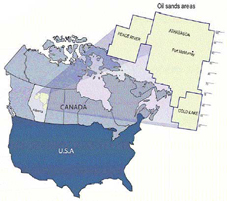Klean Industries Enters the Alberta Oil Patch
 Vancouver, Canada - Klean Industries Inc. (“KI”) announces plans to become a major participant in Alberta’s Oil Sands. The Company is aggressively looking for partners in Alberta and Saskatchewan areas with proven oil sand sites. We are moving forward with plans to establish a plant in the near term. Vancouver, Canada - Klean Industries Inc. (“KI”) announces plans to become a major participant in Alberta’s Oil Sands. The Company is aggressively looking for partners in Alberta and Saskatchewan areas with proven oil sand sites. We are moving forward with plans to establish a plant in the near term. Currently, there’s an oil boom going on right now but it’s not in Saudi Arabia or Kuwait, it’s 600 miles north of Montana. The oilmen up there aren’t digging holes in the sand and hoping for a spout. They’re digging up dirt — dirt that is saturated with oil. They’re called oil sands, and if you’ve never heard of them then you’re in for a big surprise because the reserves are so vast in the province of Alberta that they will help solve America’s energy needs for the next century. With 175 billion barrels of proven oil reserves in Alberta, which is second to Saudi Arabia’s 260 billion. Alberta’s oilsands deposits are Canada’s largest source of oil, with reserves estimated at between 1.7 trillion and 2.5 trillion barrels. The estimate of how many more barrels of oil are buried deeper underground is staggering. Oil sands are deposits of bitumen, a heavy black viscous oil that must be rigorously treated to convert it into an upgraded crude oil before it can be used by refineries to produce gasoline and diesel fuels. While conventional crude oil flows naturally or is pumped from the ground, oil sands must be mined or recovered in situ - meaning ‘in place.’ Oil sands recovery processes include extraction and separation systems to remove the bitumen from sand and water. Klean Industries’ proven hydrocarbon resource recovery system is a perfect match for the oil patch! The innovative cyclone technology strips the hydrocarbons from the bitumen leaving a completely “Klean” sand as the residual, with no tailings whatsoever. Within a few years, the oil sands are likely to become the most important oil reserve in the United States. Just this year Canada has become the largest oil exporter to the US and has taken the spot from Saudi Arabia. Huge, tarlike deposits in Canada and Venezuela will be critical over the next 50 years. Tar sands production is now 1 million barrels a day and is projected to increase fivefold by 2030, still about half of Saudi Arabia’s current output and less than 5 percent of world production in 2030. Still, by 2030 the tar sands may meet 16 percent of North American demand, providing a secure and large source of oil for Canada and the United States, energy analysts say. “The oil sands is well positioned to provide a sustainable bridge between nonrenewable fossil fuels and cleaner energy options for the future,” says a report from the Alberta Chamber of Resources. U.S. Secretary of Energy Samuel Bodman spoke recently of expanding refining capacity to handle heavier crude oil. President Bush offered to put refineries on military bases. Using the Klean technology very little water is required during the process unlike traditional systems currently in production which use high-pressure steam injected underground to separate the valuable oily bitumen from the sand, consuming huge amounts of water. Traditional systems are energy intensive, as the equivalent of one barrel of oil is needed to process three barrels of synthetic crude. Production of conventional oil requires much less energy. Hydrogen is later added to turn it into synthetic crude. Developing tar sands also raises serious environmental concerns. Traditionally it takes two tons of mined sand to produce one barrel of synthetic crude, leaving lots of waste sand but not with the Klean Industries system. Because of the energy-intensive production, oil sands are large sources of greenhouse gas emissions, but by using the Klean technology these emissions are drastically reduced. A recent Senate bill on oil shale highlights the growing importance of nonconventional production. The bill defines not only oil as a strategic hydrocarbon resource but also oil shale, tar sands, and coal- and gas-derived liquids. Whether nonconventional oil can provide a smoother passage to the future depends heavily on when world oil production starts its expected decline. The International Energy Agency forecasts production could peak between 2013 and 2037 and most likely about 2030. With the early scenario, the nonconventional output would shoot to 37 million barrels a day by 2030, the agency says, as higher prices make more production practical. This would be close to a third of all world oil production and would make up “for part of the sharp decline in conventional production,” the agency says in its 2004 World Energy Outlook. If you have an oil sands project or property that you would like to develop using the latest in (BAT) technologies. CORPORATE HEADQUARTERS Klean Industries Inc. Suite 2500 - 700 W. Georgia St, Vancouver, BC, Canada, V7Y1B3 (T) +1.604.637.9609 (T) +1.866.302.5928 (F) +1.604.637.9609 (E) sales(@)kleanindustries.com |
You can return to the main Company News page, or press the Back button on your browser.

